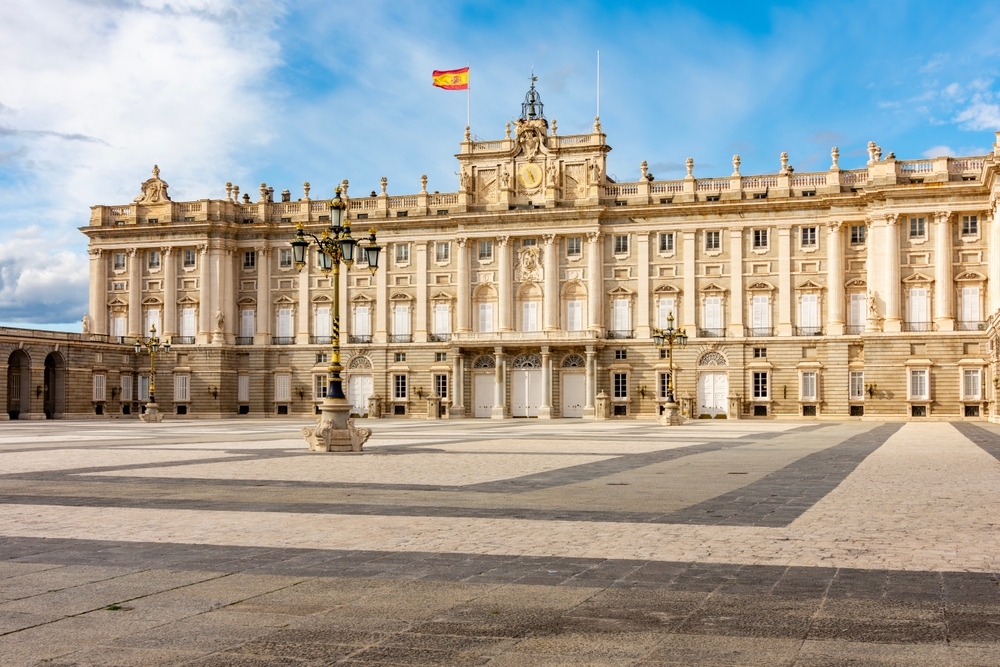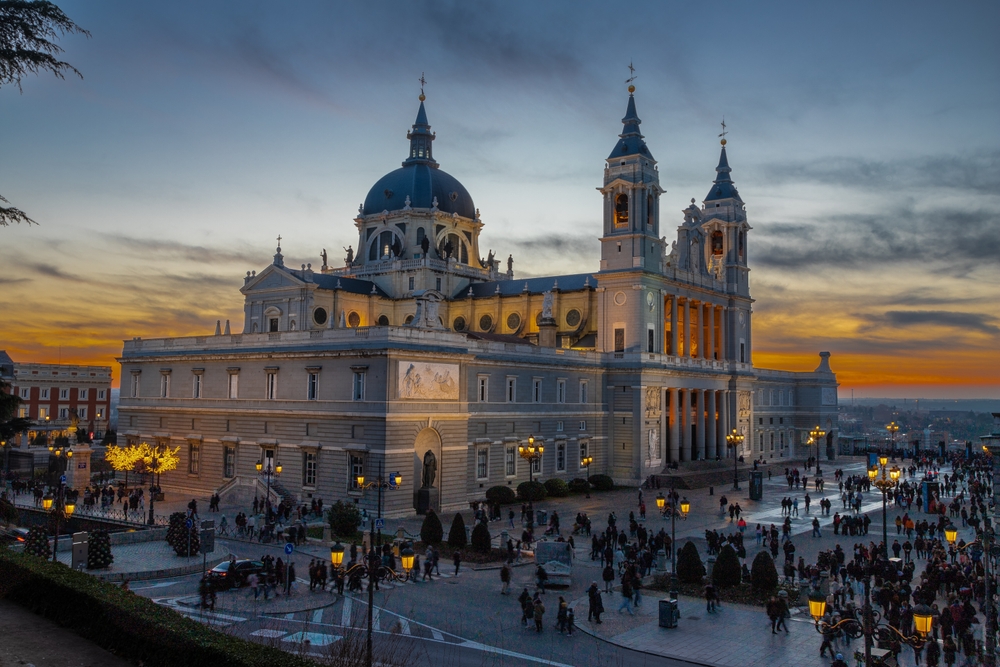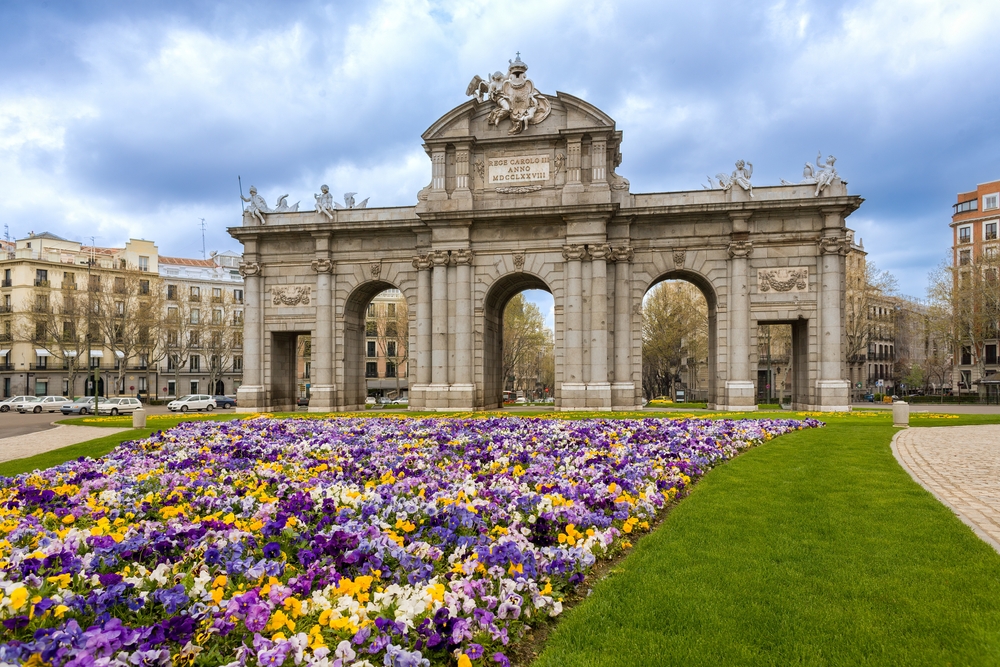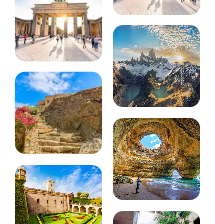9 must-see historic monuments in Madrid

Madrid is packed with architectural treasures that tell the fascinating story of Spain. From the royal era to Arab influences and contemporary monuments, the Spanish capital offers an exceptional heritage well worth exploring. Discover the 9 must-see historic monuments in Madrid, true witnesses to the cultural and artistic wealth of this magnificent city. Each monument reveals a unique facet of Madrid’s identity, between tradition and modernity.
200 audioguided tours for cities all around the world
Download1. The Plaza Mayor: the historic heart of Madrid
It’s impossible to talk about the must-see historic monuments in Madrid without starting with the Plaza Mayor, the very heart of the Spanish capital. This emblematic square, built in the 16th century and rebuilt after a fire in the 19th century, impresses with its imposing dimensions and harmonious architecture.
With its ochre-red facades and 237 perfectly aligned balconies, the Plaza Mayor is a testament to Spanish architectural genius. The Casa de la Panadería, adorned with colourful frescoes, and the Casa de la Carnicería majestically frame this rectangular square measuring 129 by 94 metres. In the centre stands the equestrian statue of Philip III, a reminder of the grandeur of the royal era.
Today, the Plaza Mayor remains an essential meeting place for locals and visitors alike. Its lively terraces and cultural events perpetuate Madrid’s popular tradition. To discover all the secrets of this exceptional monument, let yourself be guided by theNavaway route, which will reveal the fascinating history of this architectural jewel.
Also in the Madrid guide:
- Top 14 culinary specialities in Madrid
- Which district to visit in Madrid
- 12 free things to do and see in Madrid
- Top 5 activities in Madrid
- Top 10 best hotels in Madrid
- Which district to visit in Madrid?
- Visit the Las Ventas bullring in Madrid
2. The Royal Palace: a symbol of Spanish grandeur
Madrid’s Royal Palace stands as one of Europe’s most spectacular historical monuments. Built in the 18th century on the orders of King Philip V, this Baroque palace impresses with its colossal dimensions: over 135,000 square metres and 3,418 rooms, making it the largest royal palace in Western Europe.
The architecture of the Royal Palace bears witness to the refinement of Spanish decorative art. Its ceremonial rooms, adorned with frescoes by Tiepolo and period furniture, house exceptional collections: royal armour, musical instruments including a precious Stradivarius, and Flemish tapestries. The Throne Room, with its ceiling painted by Tiepolo, is one of the architectural jewels of this historic monument, a must-see in Madrid.
The Campo del Moro and Sabatini gardens harmoniously complete this royal ensemble. Although the Spanish royal family no longer resides here, the palace remains the venue for important official ceremonies. To fully appreciate the richness of this exceptional monument, don’t hesitate to follow theNavaway audio tour, which will reveal the secrets of this royal residence.
3. Almudena Cathedral: a neoclassical jewel

Facing the Royal Palace stands the majestic Almudena Cathedral, a unique historical monument in Madrid. Unlike traditional medieval cathedrals, this one was not completed until 1993, after more than a century of construction that began in 1883.
The architecture of Almudena Cathedral is a harmonious blend of styles: a neoclassical façade in harmony with the Royal Palace, a neo-Gothic interior with slender vaults, and a neo-Romanesque crypt of impressive dimensions. This architectural diversity makes it one of the most original historical monuments to visit in Madrid.
The interior is striking for its brightly coloured contemporary murals, the work of twentieth-century Spanish artists. The 75-metre-high dome offers an exceptional panoramic view of the capital. The cathedral takes its name from the Virgin of Almudena, patron saint of Madrid, whose statue adorns the high altar. This must-see religious monument bears witness to Madrid’s ability to combine traditional and modern architecture.
4. The Temple of Debod: an Egyptian treasure in the heart of Madrid
The Temple of Debod occupies a unique place among the must-see historical monuments in Madrid. This authentic Egyptian temple, dating from the 2nd century BC, was donated to Spain by Egypt in 1968, in gratitude for its help in saving the monuments of Nubia threatened by the construction of the Aswan Dam.
Reconstructed stone by stone in the Parc de la Montagne, this temple dedicated to the gods Amon and Isis features remarkable Nilotic architecture. Its perfectly preserved hieroglyphic reliefs and interior rooms transport visitors back to ancient Egypt, creating a striking contrast with Madrid’s urban environment.
Download the audio-guided tour to discover Madrid on foot and on your own
Explore Madrid in a different way with our interactive audio tour that takes you on a journey of discovery of the Spanish capital’s must-see historic monuments. From the Plaza Mayor to the Temple of Debod, via the Royal Palace and Almudena Cathedral, enjoy a unique immersive experience with 24 captivating audio commentaries that reveal the history and anecdotes of each emblematic place.
The sunset from the temple gardens offers one of the finest views of Madrid, with the silhouette of the cathedral and royal palace silhouetted against the horizon. This unusual historic monument is a remarkable addition to Madrid’s architectural heritage and a must-see on your guided tour of the city.
5. The Puerta de Alcalá: Europe’s first triumphal arch

The Puerta de Alcalá is one of Madrid’s most photographed historic monuments. Built in 1778 on the orders of King Charles III to designs by the Italian architect Francesco Sabatini, it holds the prestigious title of being the first triumphal arch built in Europe after the fall of the Roman Empire.
This neoclassical monument in Guadarrama granite impresses with its perfect proportions and sculpted details. With its five arches – three rectangular and two semi-circular – and its allegorical decorations representing the royal virtues, the Puerta de Alcalá bears witness to the urban planning ambitions of the Spanish Bourbons.
Located at the entrance to Retiro Park, it once marked the eastern boundary of Madrid and the old road to Alcalá de Henares. This must-see historic monument in Madrid (Plaza de la Independencia, 28001 Madrid, rated 4.4/5 on Google out of 15,000 reviews) remains a symbol of Spanish architectural elegance and an essential stop-off point for understanding the capital’s urban evolution.
6. The Prado Museum: temple of universal art
The Prado Museum is one of Madrid’s must-see historic monuments, as much for its neoclassical architecture as for its exceptional collections. Inaugurated in 1819, this building designed by Juan de Villanueva is one of the most prestigious art galleries in the world.
The architecture of the museum, with its granite façade and Doric columns, bears witness to the neoclassical aesthetic of the early 19th century. Successive extensions, notably by Rafael Moneo in 2007, have enabled this historic monument to be adapted to contemporary museographic requirements while preserving its architectural character.
The Prado houses over 8,000 paintings, including masterpieces by Velázquez, Goya, Rubens and Bosch. The richness of its collections makes this museum much more than a mere monument: it is a veritable sanctuary of Western art. The Prado district, a UNESCO World Heritage Site, confirms the cultural importance of this emblematic Madrid landmark.
7. Las Ventas bullring: a neo-Mudejar masterpiece
The Las Ventas bullring is one of Madrid’s most emblematic historical monuments. Inaugurated in 1931, this bullring designed by the architect José Espeliú is the largest in Spain, with a capacity of 23,798 spectators.
The neo-Mudejar architecture of Las Ventas is impressive for its decorative richness. Red brick facades decorated with azulejos (ceramic tiles) in the colours of the Spanish provinces, horseshoe arches and Islamic geometric motifs create a harmonious architectural ensemble that is unique in Madrid.
In addition to their bullfighting function, these arenas are an exceptional historical monument bearing witness to 20th-century neo-Mudejar art. The integrated Museo Taurino (Bullfighting Museum) offers a fascinating insight into the history and culture of Spanish bullfighting. This architectural marvel at Calle de Alcalá, 237, 28028 Madrid, rated 4.3/5 on Google out of 12,000 reviews, is a must-see if you want to understand an important facet of Madrid’s cultural identity.
8. The Palais de Cybèle: from the post office to the town hall

The Palacio de Cibeles (Palace of Cybele) is one of Madrid’s must-see historic monuments. Built between 1907 and 1919 by architects Antonio Palacios and Joaquín Otamendi, this sumptuous building originally housed the headquarters of the Spanish Post and Telegraph Company.
The eclectic architecture of this monument blends neo-Gothic, neo-Plateresque and Art Nouveau influences. Its 30-metre central tower, sculpted gargoyles and richly decorated façades make this palace one of Madrid’s most photographed buildings. The interior, with its spectacular glass-covered patios, bears witness to the architectural refinement of the early twentieth century.
Since 2007, the palace has housed Madrid City Hall and the CentroCentro cultural centre. Its panoramic terrace offers breathtaking views over the city, making this historic monument a privileged vantage point. Located in Plaza de Cibeles, 28014 Madrid, and rated 4.5/5 on Google out of 8500 reviews, it symbolises the successful transformation of Madrid’s historic heritage.
9. Atocha Station: railway architecture and tropical garden
Atocha Station brings our selection of must-see historic monuments in Madrid to a surprising close. This station, the oldest in Madrid (1851), is a remarkable example of 19th-century railway architecture, redesigned after a fire by Alberto de Palacios.
The transformation of the former station into a tropical garden in the 1990s represents a unique architectural feat. Under the magnificent 157-metre-long metal canopy, a 4,000-square-metre ecosystem is home to more than 7,000 tropical plants of 260 different species, as well as turtles and exotic fish.
This bold conversion makes Atocha station much more than just a transport infrastructure: it is a veritable historic monument where 19th-century industrial architecture blends harmoniously with a contemporary landscape design. This marvel, located at Plaza del Emperador Carlos V, 28045 Madrid, rated 4.4/5 on Google out of 25,000 reviews, is a perfect illustration of Madrid’s ability to reinvent its architectural heritage.
To discover all of Madrid’s must-see historic monuments in their urban context, let Navaway guide you through an immersive experience that will give you an authentic and rewarding visit to Madrid.
In conclusion, Madrid has an exceptionally rich architectural heritage that bears witness to its thousand-year-old history. These 9 must-see historic monuments, from the Plaza Mayor to the Temple of Debod, via the Royal Palace and the Las Ventas bullring, tell the fascinating story of the Spanish capital’s evolution. Each monument reveals a unique facet of Madrid’s identity, combining royal, religious, artistic and popular influences. For a complete and authentic discovery of these architectural treasures, don’t hesitate to explore Madrid with theNavaway audio tour, which will reveal all the secrets of this extraordinary city.
Frequently asked questions
What is Madrid’s oldest monument?
The Temple of Debod is the oldest monument in Madrid, dating back to the 2nd century BC. Although it did not originate in Madrid but in Egypt, it is the oldest structure in the city. Among Madrid’s monuments, the churches of St Peter the Elder and San Andrés are among the oldest historical buildings.
How long does it take to visit all these monuments?
To visit Madrid’s 9 must-see historic monuments, you should ideally allow 3 to 4 days. One day can be devoted to the historic centre (Plaza Mayor, Royal Palace, Cathedral), another to museums (Prado), and a third to more distant monuments such as Las Ventas. The Navaway itinerary optimises your route for efficient discovery.
Which monuments in Madrid are free?
Several of Madrid’s historic monuments are free: the Temple of Debod, the Plaza Mayor, the Puerta de Alcalá, and the exteriors of all the monuments. The Prado Museum is free from 6pm to 8pm on weekdays and from 5pm to 7pm on Sundays. The Almudena Cathedral is free except for access to the dome.
When is the best time to photograph these monuments?
The golden hour (an hour after sunrise or before sunset) offers the best conditions for photographing Madrid’s monuments. The Temple of Debod at sunset, the Plaza Mayor in the early morning, and the Royal Palace from the Sabatini gardens in the late afternoon are all great photo opportunities.
200 audioguided tours for cities all around the world
Download
